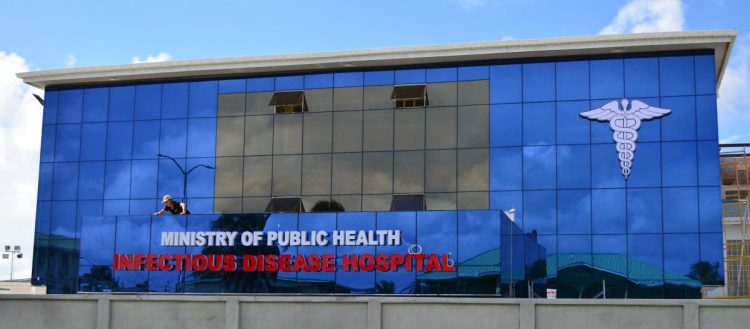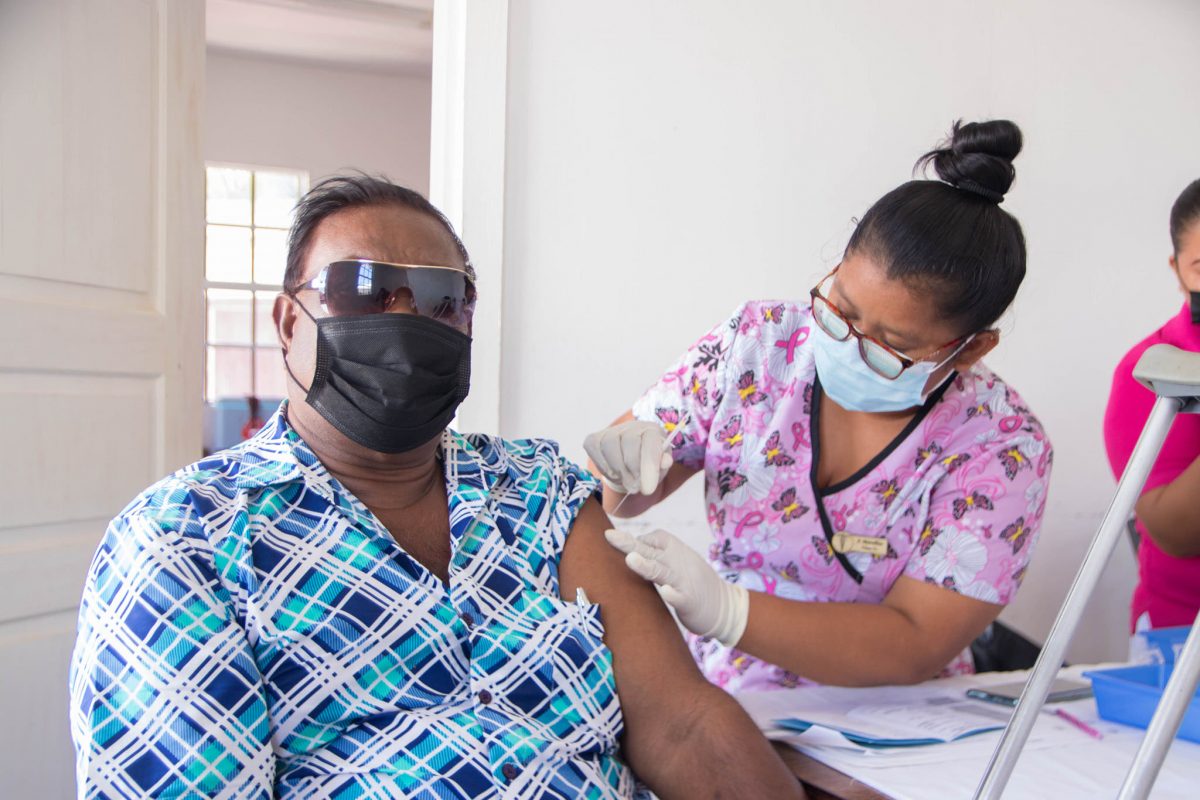As at June this year, “nearly 60% of all COVID-19 deaths were persons who had complications arising from arterial hypertension and type II diabetes.”
This is according to the Ministry of Finance mid-year report on health which notes that a whopping $2.2 billion has been spent on purchasing COVID-19 vaccines to protect the population.
The report noted that given the multi-dimensional threat which the pandemic poses to all facets of life, Government expanded allocation to the health sector in 2021 and that—as at midyear—of the $53.5 billion budgeted—$26.7 billion was expended—of which $8 billion was for drugs and medical supplies.

According to the report in Government’s bid to “protect the population,” it has embarked on an “aggressive” vaccination programme.
According to statistics from the report, at the middle of this year, just over 112,000 persons had been fully vaccinated, while just over 230,000 had received their first dose. “Once the latter group receives their second dose, taken together, about 48.1% of the adult population would be fully vaccinated,” the report said; while adding that during the latter half of 2021, “subject to vaccine availability, Government intends to offer vaccines to at least 80% of the population before the year ends.
The report said that expanded testing for COVID-19 was supported by the acquisition of seven additional GeneXpert machines for seven sites in Regions 1, 4, 6, 7, 9 and 10 which was added to the complement of testing facilities during the first quarter of 2021, “improving the daily capacity to 2,000 PCR tests from 1,200 tests at the end of 2020.”
It said further that the Infectious Disease Centre at Liliendaal where COVID patients are warded, has been outfitted with a capacity of 28 and 174 in the intensive care unit and the general wards, respectively.
During the remaining half of the year, it said that Government intends to undertake and complete the installation of a medical gas transmission system in the Centre which will result in 170 beds being outfitted with individual gas outlets to allow for oxygen support to patients.
The report says that while the limited health workforce has been dispersed to respond to COVID-19—having screened nearly 9,000 persons for non-communicable/chronic diseases during the first half of 2021—Government anticipates being able to redeploy human resources to screen an additional 21,000 persons during the second half of this year.
Noteworthy the report says—the screenings done up to August 27th, 2021 have resulted in 19,346 persons newly diagnosed for chronic diseases—and will allow for early treatment, where necessary, and active case management.
Meanwhile, with specific regard to the diabetic prevention and rehabilitation clinic, the report says that Government anticipates commencing construction in the third quarter with completion anticipated for the first quarter of 2022.
The report notes that after becoming available to Guyana, Government this year rolled out its vaccination campaign given the gradual improvements in the global vaccine supply chain in its bid at achieving high levels of immunity within the adult population.
The report said that this vaccination programme alone is anticipated to place an additional call on the Treasury by approximately 0.3 % of GDP, even as Government received, through the COVAX facility, 62,400 vaccines to support national vaccination efforts, as at the half year mark, and anticipates a balance of the Guyana COVAX allocation of 38,400 in the second half.
Communicable diseases
As it relates to communicable diseases, the report said that some $593.3 million of the budgeted $900 million for the procurement of HIV-related testing and treatment, including for antiretroviral, medication have been expended, which should ensure that the country has a stock of 14 months of treatment for its 8,952 patients.
With regard to malaria, the report said that Government has commenced the distribution of the long-lasting insecticidal nets to over 36,000 persons at the middle of this year in Regions 1 and 9; but according to the report, “though challenged by the limited human resources due to the demands of the COVID-19 response, it is anticipated that this programme will accelerate during the second half of this year with 28,500 nets anticipated to be distributed in Regions 7, 8 and 10.”
The report says, too, that health authorities intend to bolster malaria surveillance and, by extension, reports of incidence of this vector-borne disease. There have been 8,118 cases of malaria reported during the first half of 2021, compared to 7,508 during the corresponding period in 2020.
New Mental Health Act
The report also notes what it describes as Government’s successful completion of the first draft of the new Mental Health Act which is intended to replace the archaic 1930 edition. The draft Act the report says, will address areas such as procedures of mental health care not requiring consent by individuals, psychosurgery, electroconvulsive therapy and establishment of a community mental health service model, among others.
Regarding the integration of mental health services across health centres, the report says that the community health model will be used; while noting that additionally, Government has advanced the process of establishing a mental health ward at the Georgetown Public Hospital Corporation (GPHC) and notes that a consultant has been contracted to design the ward for which construction is expected in the last quarter of 2021.
In the area of family and primary health care services, the report says that Government has also expended $18.2 million on the financing of maternal waiting homes and facilities at Moruca, Kato and Enmore. The environmental and social assessments for the Enmore home commenced in June and the Moruca assessment was expected to commence last month. The Moruca and Kato homes are expected to be completed by the end of this year, while the Enmore home is slated for completion in 2022.
Meanwhile, to ensure that health workers are able to deliver the required services, the report says that Government has expended $217 million of the budgeted $1.8 billion to procure medical equipment. Equipping of the National Ophthalmology Hospital is expected to be completed by the end of the year. The report further notes that Government has successfully completed a standardization exercise which is intended to result in the improved efficacy and sustainability of medical equipment acquisition; and that it will also be procuring an emergency medical vehicle and other equipment to enhance the efficiency of the emergency medical services.
Health Infrastructure
According to the report, another area seeing multi-million investment is the expansion of health infrastructure. On this point it says that Government has “made progress with modernising and expanding health infrastructure, with $702 million expended as at the half year mark and a total of $2.2 billion anticipated to be expended by year end.
The report said that the COVID-19 pandemic continues to place a strain on public health systems. To address the challenge of limited human resources, it said that health authorities endeavoured to reassign healthcare workers to support an aggressive COVID-19 response in order to prevent the loss of life, though this has created challenges in delivering regular healthcare services which were further compounded by the restrictions on movement imposed by the COVID-19 Emergency Measures.
The report said that the GPHC has also afforded the COVID frontline healthcare workers a risk allowance while eligible workers continue to receive their on-call allowance. To supplement the human resource needs, the report said that Government has pursued the temporary employment of retired healthcare workers; while, to address the challenge of inadequate drugs and medical supplies, Government has undertaken to procure sufficient quantities to ensure stock availability into 2022, at minimum.
According to statistics from the report, in 2020, Government expended $16.7 billion on the COVID-19 response, of which $7.1 billion related to the health sector, representing 13.9% of the total health sector spending.
This, the report says included outfitting the annex to the GPHC, in Liliendaal, to adequately receive and treat moderate to severe COVID-19 cases. Further, $7 billion was expended on the COVID-19 cash grant programme which saw the commencement of distribution of $25,000 to every household across the country as a form of livelihood support.
The report said that additional sums were expended to procure sanitizing agents, personal protective equipment, ventilators, and other necessary equipment and supplies and that Government also received external in-kind support from bilateral partners including China, India and Colombia in the form of personal protective equipment, ventilators, and vaccines, among others.
Notwithstanding all of this, however, the report indicated that the expenditure pressure to respond to COVID-19 is further complicated by the fact that those who suffer from chronic diseases, such as diabetes and hypertension, are more likely to develop severe symptoms should they contract the coronavirus.
According to the report, the data thus far shows that COVID-19 related deaths are more prevalent in persons who already suffer from hypertension (over 30 percent) and type-II diabetes (over 28 percent). As a pre-emptive strategy to attempt to minimise deaths, the report said that Government has prioritized intensifying its Non-Communicable Diseases Programme in order to increase screening and treatment of persons with comorbidities and to promote healthier lifestyles.
This, the report said will serve to improve the immune responses of citizens to better protect against severe symptoms of COVID-19 and complications arising from comorbidities, should they contract the disease, in addition to the protection offered by the vaccines.
According to the report, given the unpredictability of the disease progression, the scale and menu of responses and related costs become highly unpredictable, the fiscal deficit of the Central Government is anticipated to deteriorate as additional outlays become required to preserve and protect the lives of all in Guyana.




